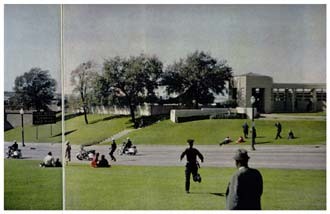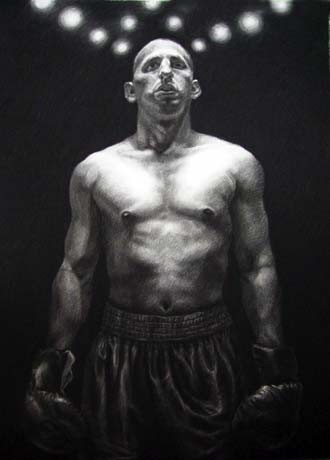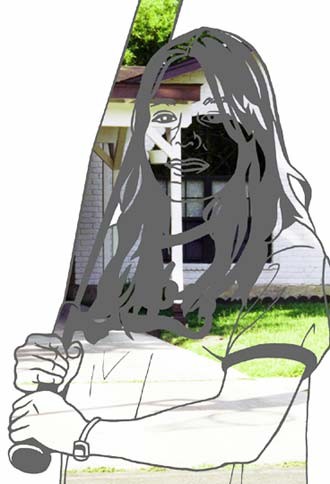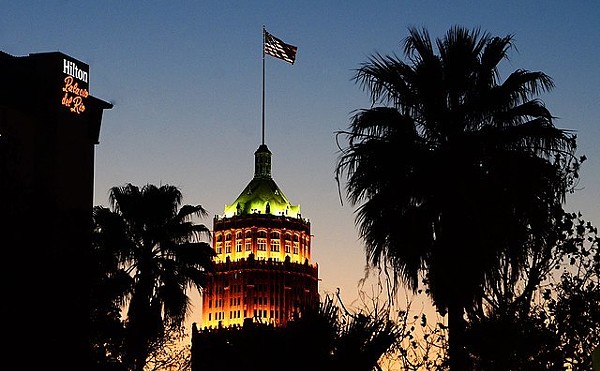Depending on your (Chicano or not) perspective, Latinos have just arrived or they're about to be obsolete
| "SUPERMAN COMES TO THE SUPERMARKET: How I found the 'REAL' MAGIC BULLET on the GRASSY KNOLL 42 years after JFK was ASSASSINATED" by 2005 Artpace resident Daniel Joseph Martinez. Racial identity, says Martinez, "is not a subject that anyone wants to talk about." |
In January, Artpace, the local contemporary art gallery and residential program, added its voice to the chorus of Texas institutions that have begun belatedly to acknowledge Latino art and artists as a distinct contribution to modern and contemporary art. "For their high-profile anniversary celebration - in the nation's ninth largest city, with a population that is itself over 50 percent Latino," reads the press release, "Artpace is devoting the entire year to guest curators whose philosophical and academic interests are focused on Latin American art." The final exhibition of the year, in the spacious Hudson Show Room, is titled Spanglish, capping off a year in which three International Artist in Residency curators will "bring multiple viewpoints from the field, with emphasis on current practice as reflected through the tradition of the mestizaje, conceptual art, and feminist theory."
The careful, almost awkward, wording is indicative of Artpace's stance, with one foot in San Antonio, where Raza identity still has a strong resonance that surfaces daily in visual art, spoken word, and music events, and another in the global contemporary art world, which has never paid much attention to identity-based work except when it employs shock tactics such as the Guerilla Grrrls infamous billboard that asked "Do women have to be naked to get into the Met. Museum?," or 1993 Whitney Biennial participant Daniel Joseph Martinez' buttons that read, "I Can't Imagine Ever Wanting to be White."
| "III: Main Event" from Valdez' series Stations, in which Valdez explored Mexican-American beliefs about manhood. |
What is often lost in these big-tent ameliorative efforts, however, is Chicano, or Mexican-American, art that grew out of the Civil Rights period in the U.S. Primarily the product of working-class and immigrant concerns, the art tended to be narrative and figurative, protesting discrimination and the plight of barrio residents and migrant workers, and championing the struggle to maintain a unique culture against the forces of assimilation. Those same threads are still visible in the work of local contemporary artists such as Vincent Valdez' boxer series and Juan Miguel Ramos' portraits based on Loteria, as well as San Anto Cultural Arts' ongoing murals project. While some of these artists have been successful on their home turf (and Valdez has found a second home in the birthplace of the Chicano art movement, Los Angeles), as Martinez points out, the number of American Latino artists who have transcended regional sucess is small.
When actor Cheech Marin's touring exhibition, Chicano Visions: American Painters on the Verge, came to town in 2001, it was widely hailed as a watershed moment, but for many Chicano and Latino artists, it provoked ambivalence over being pigeonholed at almost the precise moment that it became advantageous to have that label. Los Angeles-based Martinez is one of the first set of Artpace 2005 IAIR residents. He calls the Marin exhibition "the stupidest idea in the world," because it panders to its audience. "`Marin` speaks in the most naive, most pedestrian manner about the function of art, how he chooses it because he likes it." Common elements of Chicano and American Latino art - identity, anger, displacement - have become a formula for inclusion and even commercial success, he says. "This is all I'm trying to suggest: All the modes and ideologies people have inherited are bankrupt." Look at the artists in Mexico who inherited a revolutionary aesthetic from Diego Rivera and his contemporaries, he says. "They were dying. They had no model that could free them from the Marxist discourse. They had to drop all the pretenses to the historical, to the political."
| One-third of a triptych, "Tonantzin, Stealer of Souls, and Shorty of Gold," by Juan Miguel Ramos, whose work is populated by contemporary San Antonio Chicanos. |
As Martinez suggests, some of the people in power are interested in a broader conversation. Independent curator Victor Zamudio-Taylor, who selected Martinez for his residency, also picked Paris resident Bojan Sarcevic and local artist Cruz Ortiz, who subverts Chicano stereotypes through humor and a search for common human experience. Gabriel Perez-Barreiro, the Blanton Museum curator of Latin American Art and one of Artpace's 2005 IAIR curators, says that this generation of Chicano and Latino artists has a more complicated sense of self. "For me, 'Chicano' is a historical movement," tied to a specific place and time. "Being from several places at once is the contemporary condition," and curators want to engage in transcendent themes and dialogues. "There's a sense that identity on the one hand becomes less important and on the other hand becomes a sort of currency that people understand."
That view is a luxury, says Franco Mondini-Ruiz, a San Antonio native and Rome Prize recipient. "Everyone's saying identity issues are so five minutes ago," he observes, but he doesn't buy the notion that globalization makes ethnically defined identity less relevant. "What I'm focusing on, which is maybe unique, is the class structure even within Latino culture. I'm very interested in being aware that working-class aesthetics are often overlooked also." He says that globalization looks a lot like an exportation of American middle- to upper-class values. "If that's the case, we need to support and highlight differences, uniqueness."
Put in that context, the discussion begins to sound like a debate over the relevance of regionalism - the idea that unique work can thrive in a geographic location relatively free from outside influence - in an increasingly homogenized contemporary art world. But to Martinez, it's a matter of engaging in a conversation that only takes place at a certain level of dialogue identified as "high art." "It operates through opacity and ambiguity. That is the methodology," he argues. "If you go to DIA Beacon, go look at what their specialization is (Minimalism from Donald Judd to Richard Serra), and tell me that the craft and folk art will survive against the canonical positioning and the full weight of art history." Much of what Martinez sees identified as Chicano or Latino work falls short of this conversation, he says, because it regurgitates popular representations or relies on tropes such as cultural holidays or food. Nonetheless, he says, institutions are succumbing to guilt and pressure to highlight Latino art, and "there is no one really willing to say these enchiladas made out of ceramics are not going to be in the museum."
| New Works 05.1: Daniel Joseph Martinez, Cruz Ortiz, Bojan Sarcevic Noon-5pm Wed-Sun, noon-8pm Thu, & by appt. Through May 8 Artpace 445 North Main 212-4900 |
Martinez allows that "That's true in the most generous of circumstances," but in a democratized market system, "we have come to the point that everything in the culture has the potential to be art, which means we have lost the potential to be discriminating." In art, he says, he is seeking the "possibility of the unknown," the ability to be so provocative that it causes the viewer to question his or her most basic assumptions. That means pushing art beyond our comfort level, beyond self-affirmation and pleasure. "The richest thing you can have in a culture is a culture disagreeing with itself." •
By Elaine Wolff

















